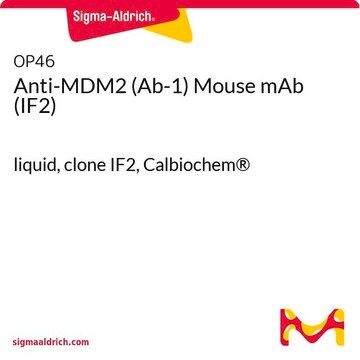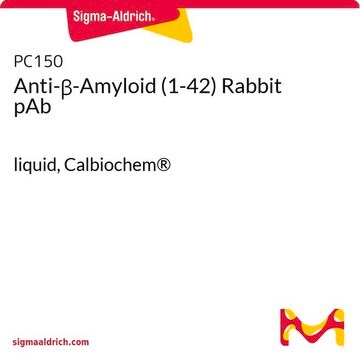OP145
Anti-MDM2 (Ab-5) Mouse mAb (4B2C1.11)
liquid, clone 4B2C1.11, Calbiochem®
Sinónimos:
Anti-Ubiquitin Protein Ligase, Anti-p53 Binding Protein, Ant-Murine Double Minute Chromosome-2
About This Item
Productos recomendados
biological source
mouse
Quality Level
antibody form
purified antibody
antibody product type
primary antibodies
clone
4B2C1.11, monoclonal
form
liquid
does not contain
preservative
species reactivity
human
manufacturer/tradename
Calbiochem®
storage condition
OK to freeze
avoid repeated freeze/thaw cycles
isotype
IgG1
shipped in
wet ice
storage temp.
−20°C
target post-translational modification
unmodified
Gene Information
human ... MDM2(4193)
General description
Immunogen
Application

Immunoblotting (2 g/ml, chemiluminescence)
Immunofluorescence (2.5 g/ml)
Immunoprecipitation (1 g/reaction, see application references)
Paraffin Sections (2.5 g/ml, heat pre-treatment required)
Packaging
Warning
Physical form
Reconstitution
Analysis Note
A549 or MCF7 cells or breast carcinoma tissue
Other Notes
Barak, Y., et al. 1993. EMBO. J.12, 461.
Ladanyi, M., et al. 1993. Cancer Res.53, 16.
Leach, F.S., et al. 1993. Cancer Res.53, 2231.
Oliner, J.D., et al. 1993. Nature362, 857.
Momand, J., et al. 1992. Cell69, 1237.
Oliner, J.D., et al. 1992. Nature358, 80.
Fakharzadeh, S.S., et al. 1991. EMBO J.10, 1565.
Legal Information
Not finding the right product?
Try our Herramienta de selección de productos.
Storage Class
10 - Combustible liquids
wgk_germany
WGK 3
Certificados de análisis (COA)
Busque Certificados de análisis (COA) introduciendo el número de lote del producto. Los números de lote se encuentran en la etiqueta del producto después de las palabras «Lot» o «Batch»
¿Ya tiene este producto?
Encuentre la documentación para los productos que ha comprado recientemente en la Biblioteca de documentos.
Nuestro equipo de científicos tiene experiencia en todas las áreas de investigación: Ciencias de la vida, Ciencia de los materiales, Síntesis química, Cromatografía, Analítica y muchas otras.
Póngase en contacto con el Servicio técnico








